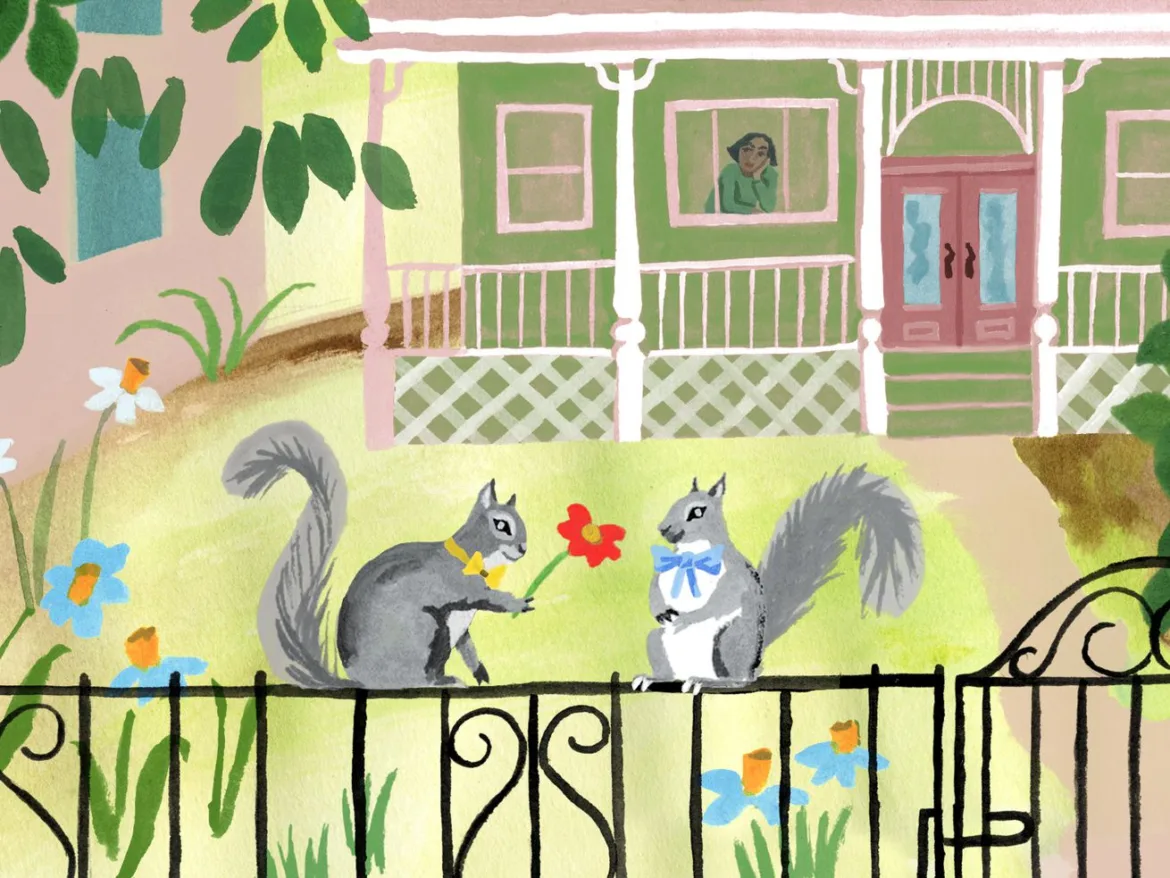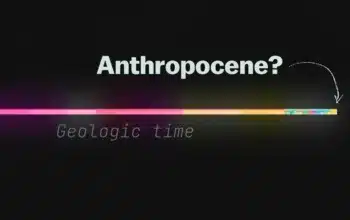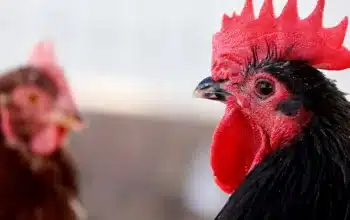How a neighborhood project to count squirrels bound me to my wild kin.
In September of 2012, when the internet was still mostly good and housing was still mostly affordable, a social media site served me a notice about something called “the Inman Park Squirrel Census Data Presentation and Spectacle.” The flyer, in tidy mid-century fonts overlaying a vintage illustration of a beaming man carpeted in woodland creatures, announced that the event — including a contest, a squirrel dance, and squirrel art — would take place around the corner from the Atlanta apartment I’d recently rented.
My first thought was: Is this real?
It was a few months after I’d moved back to town, fresh off a series of questionable professional choices and a few wildly unpleasant years in the company of Boston’s meanest doctors, hoping to pivot to a (then) less unpleasant career in public health.
I was ambivalent about being in Atlanta: I grew up in this city’s pleasant but bland suburbs, and as a chubby, ethnic, melancholy teen with no interest in youth soccer or Christian fellowshipping, I couldn’t wait to get out. When I escaped in the late 1990s, I swore I’d never come back.
Nearly 20 years later, however, the city had changed, and I was strongly starting to suspect I might not hate it. At festivals and parades and restaurants and galleries, the ocean of pale preppies I’d fled had been replaced with kaleidoscopic ambition, people and languages from all over sprouting ideas and hustle. A massive pedestrian connector now linked many of the neighborhoods my family’s yellow Chevy Malibu used to speed through on the way to the zoo, and they bloomed with improvised stages and open mics and mural art.
Atlanta in the early 2010s nourished a brand of quirk I liked; this squirrel-counting thing just meant it was that much closer to my doorstep. Plus, it promised to put a little sizzle on an area of epidemiology not all that different from mine, if you squinted.
So I went, alone, to see what story the spectacle would tell. Under strings of twinkling lights in the backyard of what was then an offbeat home decor shop (now a Ben and Jerry’s), I watched as a series of earnest nerds presented the results of a project they’d begun a year earlier: A count, a proper epidemiological census, of the eastern gray squirrels inhabiting my neighborhood.
I sat in the crowd, surrounded by onlookers wide-eyed with a blend of awe and bewildered delight, and felt something inside me simultaneously thrill and calm. These people had gathered to celebrate what looked like a community science project, and indeed, plenty of math and methodology flashed before us that night. But there was more to this odd little pageant, something warm and generous. I wasn’t a part of it, but somehow I felt invited to be.
These were my kind of weirdos. Maybe I would like it here, after all.
The Squirrel Census changed over the next 10 years: It expanded, went to the moon (or, at least, New York City), and then, abruptly, ended — sort of. I changed, too. But it left on me the mark of a wild sort of magic, a permanently reoriented gaze on the literal nature of imagination and human connection. This is why, for me, its music will never die.
How the Squirrel Census got its start
That night in 2012 was my first run-in with Jamie Allen, the project’s earnest nerd-in-chief, then a 40-something bespectacled dad with a skater-boy flop of brown hair. Allen worked days as an advertising copywriter and wrote short fiction in his free time; it was his dog’s squirrel obsession that had first sparked an idea for a story about a squirrel horde attacking a golden retriever, which then led him to wonder: How many squirrels were out there, anyway?
For Allen, who got his start making digital news at CNN, satisfying even aimless curiosity was a vocation. The people answering the phones at the US Fish and Wildlife Service and the Humane Society thought it was a funny question; Allen thought it was funny they didn’t know the answer. A week later, over beers on the back deck of his Inman Park rental with his best friend, programmer Stewart Haddock, he brooded over the lack of data to answer his question, and in the way people do when they’re a little loaded, suggested they figure out how to count all the squirrels in Atlanta.
“Maybe you should limit it to Inman Park,” said Haddock, “because you live in it.”
Most normal people would’ve given up at this point. Allen couldn’t. He talked about squirrels and the putative counting of them to friends and strangers, at bars and at convenience stores, and over ping-pong, which he played a lot of, also mostly at bars. And the strange thing was, like the kind of uncannily selective magnet that inexorably sucks together the parts of a Voltron or assembles Avengers, the idea drew the right people together into what would eventually, serendipitously become the volunteer Squirrel Census team.
If the project were a cartoon, its origin story would make an ideal opening-credits montage, with blazing light arcs trailing each member as they’re raptured out of their quotidian lives as professional mapmakers, actual squirrel epidemiologists, and Department of the Interior forestry mavens. Each one is slammed by a gust of wind into a seat at the long pine table at Allen’s house (code-named Tom Clancy for the twin sets of dark front windows framing the entryway like a pair of aviators), and as kiddie stadium rock plays, they — on three! — vow to actually do it, to count the squirrels in Allen’s neighborhood. And to do it right.
Is the Squirrel Census science? Yes … but also, no.
That might be why the project initially appealed to me: It was the kind of science I’d moved to Atlanta to learn to do, focused not only on understanding the natural world, but on making its invisible mechanics legible to its inhabitants.
/cdn.vox-cdn.com/uploads/chorus_asset/file/25403215/24_Vox_Squirrel_spot_bench.jpg)
To be clear, counting squirrels is a totally legitimate scientific pursuit. Scientists survey them to stay ahead of threats that invasive species pose to shared habitats, and to investigate diseases that spread at the seams where human and animal life entwine. They also count squirrels to better understand the health of the environment that sustains them; like other wild animals, squirrels function as sentinels of ecological health.
Humans have been tracking squirrel migrations for at least two centuries. The most recent — the Great Squirrel Migration of 1968, in which swarms of starving eastern gray squirrels crisscrossed the eastern US, probably in search of food — was chronicled by the Danish-American wildlife biologist Vagn Flyger, who sometimes trapped the animals in his backyard using a combination of peanut butter and crushed Valium.
Flyger’s work also forms the basis of the Squirrel Census’s method for estimating a squirrel population based on point-in-time counts. In 2012, based on methods Flyger published in 1959, the team overlaid a map of the Inman Park neighborhood with a hectare grid. They assigned each hectare to a few volunteer sighters, many recruited from among family and friends. In April 2012, they recorded squirrel counts and other activity, twice in each hectare, for 20 minutes at a time. The team later used Flyger’s validated formula — which includes an adjustable factor to account for trees and other squirrel-obscuring miscellany — to estimate the neighborhood’s overall squirrel abundance.
It would be easy to confuse the Squirrel Census with science. It used validated, evidence-based, scientific methods for achieving the central goals of the project, and presented its findings in the kind of precise visual language that communicates close examination of a subject along multiple axes. And after all, most animal counts are science.
The difference, which was apparent as soon as Jamie Allen opened his mouth that night in 2012, was that the Squirrel Census’s chief purpose was to produce not science but story.
I hunted down my own copy of a squirrel heat map I’d seen mounted on the wall under the string lights that night in September. Against a spare rendering of my neighborhood’s streets, buildings, and parks in grayscale and mint green, its accounted-for squirrels clustered in overlapping bubbles of pale peach; it was the first piece of art I ever got professionally framed.
I hung it in my living room. When I invited people for dinners or parties or drinks on the covered front porch, I’d often find at least one person standing in front of the map for many minutes, staring, or looking for their house, or sometimes just murmuring, “Is this real?”
A new mythology of home
As a kid, I always felt mismatched with Atlanta, like an alien whose spaceship had taken a wrong turn on the way to its real hometown. In short order, the city would transform itself into a Summer Olympics host, then become hip-hop’s center of gravity, then blossom into something sneeringly but accurately called Y’allywood — but back then, it felt to me like a backwater, sleepy and stifling under its famous tree canopy.
When I came back in 2012, I’d had other options — which meant that now, I was an adult who had chosen to come back to the place where I’d grown up. Atlanta had changed, but the story I told myself about it had not.
At the exact moment I was looking for a new way to understand my hometown, the Squirrel Census was spinning a contemporary mythology set against its backdrop. In this new lore, we, like the ancient Greeks, looked upward to find our heroes, outlaws, tricksters, and lovers — but they were in the treetops, not the heavens, and the new Mount Olympus was just outside my door.
Who were we, the humans, in this story? What was this city I now lived in? I was no longer an awkward, undesirable teen, and Atlanta was no longer a backwater. As the Squirrel Census told it, we were a bunch of sweet, bumbling dorks bewitched by our creature kin, who themselves dwelt in a complicated world filled with good and evil, lust and subterfuge, power struggles and self-sacrifice. That this tangle of buckled sidewalks and forests and creaky old Victorian houses was the setting for their dramas cast magic dust over every branch and leaf.
Imagining these creatures’ interiority made us better people, too. Not in the sense that it was a badge of hipster honor to have perceived something through a Wes Andersonian lens, but in the sense that creating stories about these animals bonded us to them. The way Rochester felt like there was a string tied under his left ribs that connected him to Jane Eyre, a thin thread now connected us with these beasties we used to simply ignore.
When they foraged, tussled, attacked, or gave chase, it tugged a little at our ribcages, and those pangs made us — made me — care more about the place where they lived. It led me to see my neighborhood through the eyes of a squirrel, as a haven rich with resources and hiding places — and myself as a steward of their home, accountable for keeping it safe, quiet, and green. Sharing a corner of the forest with our mythical versions of these beings expanded our hearts, and we were better for it.
In which I count squirrels
Six years after I first heard about the Squirrel Census, I finally got to be part of it.
By late 2018, when the team counted the squirrels in New York City’s Central Park, I’d backed even further away from medicine and was barreling headfirst into a journalism career — which, refreshingly, felt like a good fit. I’d planned a visit to New York that happened to coincide with the count, and signed up to spend a perfect, sunny Saturday afternoon listening for chitters and watching for flashes of cinnamon fur in a section of the park across from the American Museum of Natural History. The experience was analog by design, with pencils and printed packets of thick paper for all our navigation and record-keeping.
For a decade, I had been spoiled by the blue dot on my phone’s map that always told me where I was relative to my surroundings, and I’d forgotten the squirt of dopamine that accompanies matching an actual statue or bridge or shrubbery with landmarks on a map. I lurked near a newlywed couple in the Shakespeare Garden, watching not them but a twitch of chestnut fluff foraging near a cluster of shrubs. As joggers and cyclists whizzed by, I trained my eyes upward, looking for bushy telltales in the massive American elms bordering Central Park West. New York has historically had a fraught relationship with squirrels, alternately hunting them into vanishing rarity and coddling them as pets; now, they’re everywhere.
/cdn.vox-cdn.com/uploads/chorus_asset/file/25403216/24_Vox_Squirrel_spot_fence.jpg)
My packet had spaces for me to note not only squirrel number, size, color, activity, and location but also the abundance of human and other-animal drama playing out around me and my own reactions to the theatrics. I’d also been instructed to listen for squirrel vocalizations, including kuks, quaas, and various moans. I strained my ears to disentangle critter-kibitzing from the usual park cacophony. I felt sneaky, special, a little feral.
That night, amid the tusked and taxidermied furnishings of the Explorer’s Club — the project’s New York City headquarters for the duration of the Central Park count’s planning, execution, and reveal — I schmoozed with fellow squirrel sighters. I marveled with them at how much bigger and brighter the world seemed when we saw it through a woodland animal’s eyes. We basked in our widened gaze on the world: We were a whole new kind of alive, suddenly aware of the sheer mass of life in our surroundings and overwhelmed by the sanctity of existence, of having the privilege to care about any of it. An older volunteer, one of 10 awarded an “alpha-alpha sighter” designation for extraordinary commitment to the cause, delivered an a cappella rendition of “Count Your Blessings,” only instead of “blessings,” he sang — what else? — “squirrels.”
The end (for now)
In March 2021, a year into the Covid-19 pandemic, I got a very long email announcing that at least for the moment, the Squirrel Census was disassembling, sort of. I was in Florida, watching my partner’s mother die in hospice, and was weirdly shattered by the news. At a time when it felt like all the goodness had been drained out of the earth, when we most needed ways to connect with each other and to be reminded what it was we shared, the Squirrel Census seemed like just one more casualty of the new world’s unbreathable air.
Another realization came into relief as the news sank in, related to the very specific way the pandemic kept us from museums, concerts, and parties: There’s a difference between experiencing joy and awe alone and experiencing it with others.
The Squirrel Census had knotted a thread that tethered me not only to the fast-beating hearts of the wildlife in my backyard, but to the people who’d stood beside me as we squinted into the trees, or at a poster, or just at the thought of such an absurd thing as a census of squirrels. Our politics, and then the pandemic, made those moments scarce and precious; I wasn’t yet sure if and when we would reclaim them.
Still, I understood: The Squirrel Census team was tired. Maybe they were also broke. Clearly, they needed a change. Jamie Allen liked to say people either got the Squirrel Census or they didn’t, and the people who did were special — “Life Poets,” according to that farewell note. If we were lucky, life would go on. But we would need to find its poetry somewhere else.
Eventually, the pandemic’s urgency diminished. Various team members had long since moved away to live out other dreams when Jamie, his kids now out of the house, moved to Los Angeles in 2023. After all, he said in a way that kind of broke my heart, he’d never planned to spend the rest of his life in Atlanta. Over the holidays, a Squirrel Census email turned up in my inbox with links to two peculiar, perfect little songs. In February, Allen told me the project is still on an extended hiatus. “We’re a band that’s in between albums, and we’re not really writing a current album,” he said. “But when we do, we’ll get the band back together.”
That makes sense, I think. It does feel like, all this time, I’ve been following a pied piper of sorts, if not a band. His tune did convince me there was something out there that was worth following, and following it made me better, and maybe a little weirder.
It was real.



